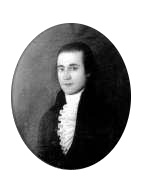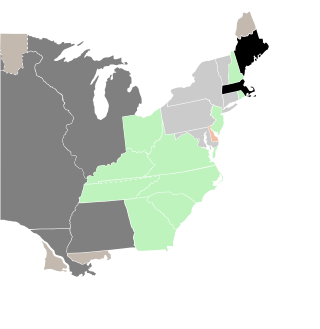
The 11th United States Congress was a meeting of the legislative branch of the United States federal government, consisting of the United States Senate and the United States House of Representatives. It met in Washington, D.C. from March 4, 1809, to March 4, 1811, during the first two years of James Madison's presidency. The apportionment of seats in the House of Representatives was based on the 1800 United States census. Both chambers had a Democratic-Republican majority.

Since Connecticut became a U.S. state in 1788, it has sent congressional delegations to the United States Senate and United States House of Representatives, beginning with the 1st United States Congress in 1789. Each state elects two senators to serve for six years in general elections, with their re-election staggered. Prior to the ratification of the Seventeenth Amendment in 1913, senators were elected by the Connecticut General Assembly. Each state elects varying numbers of members of the House, depending on population, to two-year terms. Connecticut has sent five members to the House in each congressional delegation since the 2000 United States Census.

Calvin Willey was an American politician from Connecticut who served in the United States Senate from 1825 to 1831.

The 1812–13 United States House of Representatives elections were held on various dates in various states between August 3, 1812, and April 30, 1813. Each state set its own date for its elections to the House of Representatives before the first session of the 13th United States Congress convened on May 24, 1813. They coincided with James Madison being re-elected president.

The 1810–11 United States House of Representatives elections were held on various dates in various states between April 24, 1810, and August 2, 1811. Each state set its own date for its elections to the House of Representatives before the first session of the 12th United States Congress convened on November 4, 1811. They occurred during President James Madison's first term. Elections were held for all 142 seats, representing 17 states.

Samuel Whittlesey Dana was an American lawyer and politician from Middletown, Connecticut. He represented Connecticut in both the U.S. House of Representatives and Senate.

Barnabas Bidwell was an author, teacher and politician of the late 18th and early 19th centuries, active in Massachusetts and Upper Canada. Educated at Yale, he practised law in western Massachusetts and served as treasurer of Berkshire County. He served in the state legislature as representative and senator, as well as in the United States Congress as spokesman for the administration of Thomas Jefferson. He was effective in defending the administration's positions and passing important legislation. He resigned his seat in Congress in July 1807.
Lyman Law, son of Richard Law and father of John Law, was a United States representative from Connecticut. He was born New London, Connecticut. He pursued classical studies and was graduated from Yale College in 1791. He studied law and was admitted to the bar in 1793 and commenced practice in New London.

John Tod was an American judge and politician who served as a Democratic-Republican member of the U.S. House of Representatives for Pennsylvania's 8th congressional district from 1821 to 1823 and for Pennsylvania's 13th congressional district from 1823 to 1824. He served as a member of the Pennsylvania State Senate for the 14th district from 1815 to 1818 including as Speaker from 1815 to 1816 and as a member of the Pennsylvania House of Representatives from 1810 to 1813 including two terms as Speaker.

The 1810–11 United States Senate elections were held on various dates in various states. As these U.S. Senate elections were prior to the ratification of the Seventeenth Amendment in 1913, senators were chosen by state legislatures. Senators were elected over a wide range of time throughout 1810 and 1811, and a seat may have been filled months late or remained vacant due to legislative deadlock. In these elections, terms were up for the senators in Class 2.

Connecticut elected its members September 21, 1812.

Maryland held its elections October 1, 1810.

A special election was held in Connecticut's at-large congressional district on September 17, 1810 to fill a vacancy left by the resignation of Samuel W. Dana (F) in May, 1810 after being elected to the Senate.
Massachusetts held its elections November 5, 1810. Massachusetts law required a majority for election. This was not met in the 15th district necessitating a second election on April 1, 1811.
The 1810 United States elections occurred in the middle of Democratic-Republican President James Madison's first term, during the First Party System. Members of the 12th United States Congress were chosen in this election. During the 12th Congress, Louisiana joined the union. Democratic-Republicans continued to control both chambers of Congress.
United States gubernatorial elections were held in 1810, in 13 states, concurrent with the House and Senate elections.

The 1810 Connecticut gubernatorial election took place on April 9, 1810.
This page is based on this
Wikipedia article Text is available under the
CC BY-SA 4.0 license; additional terms may apply.
Images, videos and audio are available under their respective licenses.












